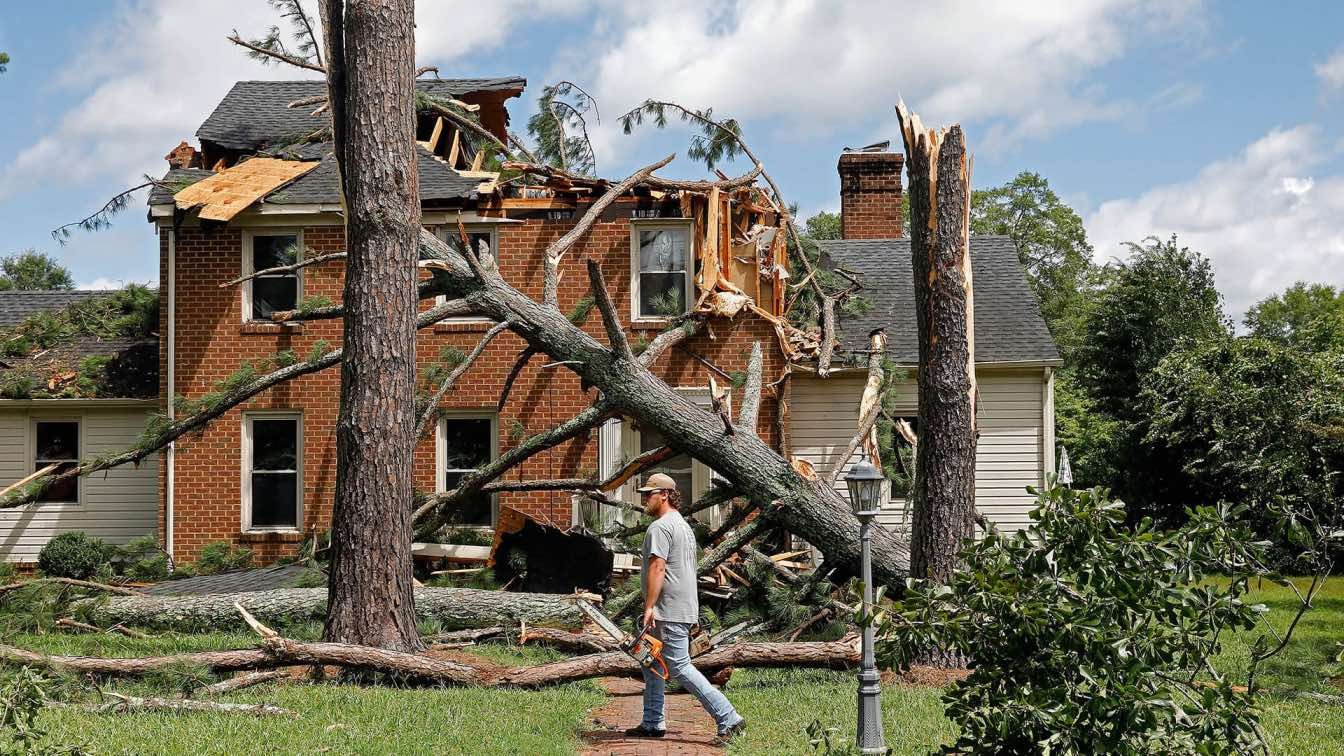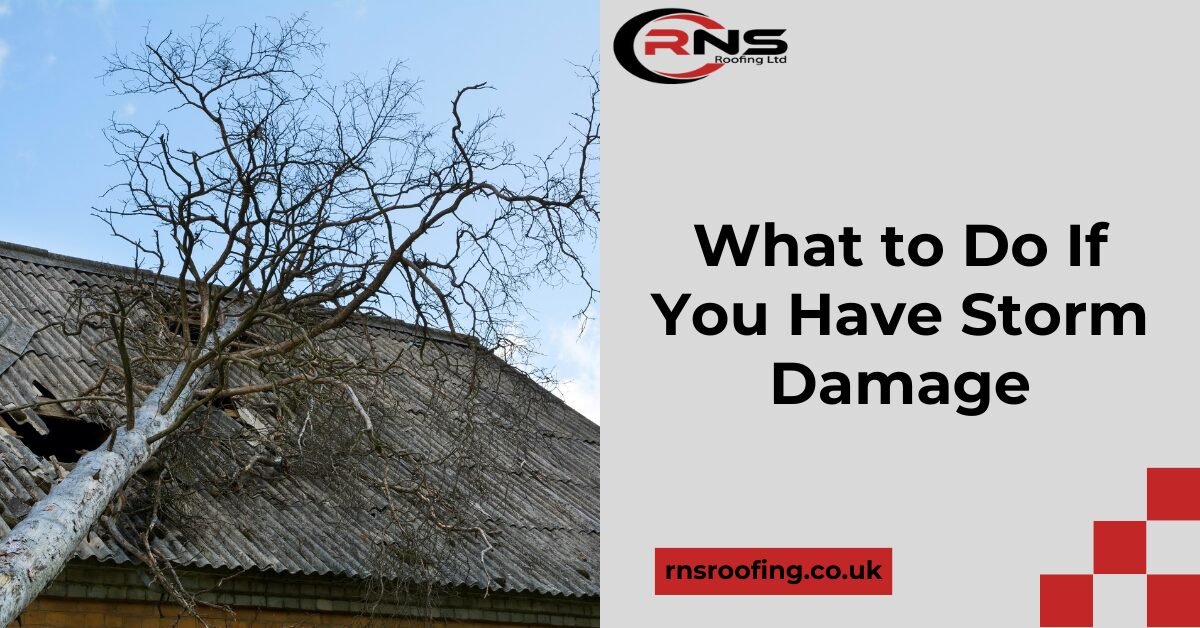A recently installed roof should withstand bad weather. However, Mother Nature occasionally has different ideas. Don’t panic if you discover storm damage! Although it might be frustrating, it’s important to stay calm and take the right steps to get things back to normal. This guide covers everything you need to know about handling storm damage, from inspecting the damage to assessing repairs and handling insurance claims.
It’s crucial to act quickly to protect your home. This guide outlines how to fix roof damage and what to do if you have storm damage roofing issues don’t go away.
4 Types of Roof Storm Damage
Some types of storm damage are instantly obvious, while others need further inspection. Here are key types of storm damage that affect roofs:
Fallen Trees or Debris
Large storms can cause serious damage by dropping trees, branches, or other debris onto your roof, creating large holes. This is the most obvious type of damage and often requires the most extensive repairs.
2. Torn, Denied, or Missing Shingles:
If the primary roofing material on your house is shingles, you might observe some damage to them during a strong storm. Here are some things to be aware of:
- Torn shingles are typically caused by high winds tearing them in half.
- Dented shingles are often due to hail and may appear as dark spots. Loose shingle granules in gutters are another sign.
- Missing shingles indicate shingles have been completely ripped off.
3. Dented Gutters:
Gutters, while designed to channel water away, aren’t always resistant to severe storms. Hail and high winds can dent, bend, or break gutters, reducing their effectiveness.
4. Leaks:
If a storm creates holes or removes shingles, leaks are likely. Check for signs of water damage in attics or ceilings.

What to Do If You Have Storm Damage
After a storm, acting quickly is crucial to minimize further damage to your home. Following these essential steps will help you manage the situation effectively:
Step 1: Assess the Damage Safely
Safety First:
Before inspecting your roof, ensure it’s completely safe to do so. Wait until the storm has fully passed, and if you suspect any serious damage or risk, it’s always best to leave the task to professional roofers. Climbing onto the roof can be hazardous, especially after heavy winds or rainfall.
Ground Inspection:
Begin your inspection from the ground. Look for any visible signs of damage like missing or cracked roof tiles, dents on metal roofs, or shingles that may have been blown off and scattered around your property. This gives you an idea of the extent of the damage before seeking professional help.
Interior Inspection:
Inside your home, check areas like the attic and ceiling for any signs of leaks or water stains. These can be indicators of roof damage, even if it’s not immediately visible from the outside.
Documentation:
It’s vital to document all visible damage by taking clear photos and videos. This evidence will be crucial when filing an insurance claim and can help you during negotiations with your insurance company.
Step 2: Understanding Repair Options
The type and extent of damage your roof has sustained will determine the type of repairs needed:
Minor Damage:
In the case of minor issues like a few missing or cracked shingles, the repair process is typically straightforward and relatively affordable. Small repairs, like patching up areas with missing shingles, can prevent bigger problems later on.
Moderate Damage:
If multiple sections of the roof have been damaged, you may require more extensive repairs. This could include replacing large sections of tiles or waterproof membranes beneath the roof surface. Such repairs may take longer and come at a higher cost but are necessary to ensure the long-term integrity of the roof.
Major Damage:
In cases of significant structural damage, such as if large parts of the roof are damaged or destroyed, a complete roof replacement might be the only solution. This is especially true if the roof was already nearing the end of its lifespan before the storm.
Newly Installed Roof Considerations:
While your roof may be completely new, keep in mind that warranties usually only cover flaws in production and not storm damage. However, extra coverage for specific events like hail or windstorms may be provided by certain warranties. Examine your warranty documentation carefully.
Step 3: Contacting Your Insurance Company
Making an insurance claim can reduce the expense of roofing storm damage repair. What you should know is as follows:
Filing the Claim:
Once you have assessed the damage and documented everything, contact your insurance company as soon as possible. Provide them with a detailed account of the damage, along with the photos and videos you’ve taken.
Adjuster Visit:
Your insurer will send an adjuster to inspect the damage and estimate the repair costs. It’s helpful to be present during this visit so you can point out specific areas of concern.
Claim Decision:
After the adjuster’s report, your insurance company will decide how much they are willing to cover for the repairs. This is based on the extent of the damage and your policy’s terms.
Negotiation:
If you feel that the payout is insufficient or doesn’t fully cover the repair costs, you can negotiate with your insurer. Gather repair estimates from local roofing contractors to support your case.
Step 4: Selecting a Qualified Roofing Contractor
Choosing the best contractor is important for ensuring correct repairs and optimizing your insurance payout. Here are some guidance:
Get Multiple Estimates:
It’s essential to get at least three estimates from reputable roofing contractors before making a decision. This helps you compare prices and services to find the best option for your needs.
Check Credentials:
Ensure the contractor you choose is licensed, insured, and has a solid track record of handling storm damage repairs. This will give you peace of mind knowing your roof is in good hands.
Communication is :
Clear communication with your contractor is critical. Choose someone who is transparent about the process, offers honest advice, and keeps you updated throughout the repairs.
Contractual Agreement:
Make sure you have a legal agreement that outlines the work to be done, products to be used, warranties to be issued when payments are due, and how to coordinate insurance claims before any work starts.
Step 5: Repair and Recovery
Once you’ve selected your contractor, the repair work can begin. Ensure you stay informed throughout the process and inspect the completed work to make sure it meets your expectations.
Conclusion:
Storm damage to a newly installed roof can be unsettling, but you can effectively address it with quick action and the right repair solutions. By conducting a thorough inspection, determining the type of damage, and arranging timely repairs, you’ll restore your roof’s integrity and protect your home. If you’re uncertain or dealing with extensive damage, don’t hesitate to call a professional roofing contractor.
FAQs About What to Do If You Have Storm Damage
How soon after a storm should I inspect my roof?
After a storm, it’s advisable to inspect your roof as soon as it’s safe to do so. Putting off the storm damage roof inspection could make the damage worse and require more significant repairs.
What if I can’t afford roof repairs after storm damage?
Talk to your insurance company and roofing contractor about your payment choices if you can’t afford the repairs upfront. To assist homeowners in paying for repairs, several contractors provide financing or payment plans.
Should I inspect my roof myself for roof storm damage?
In general, it is safer to have a professional check your roof for damage, particularly if you are not skilled in roof maintenance. They can spot potential dangers and concealed damage.
Will my insurance cover the cost of storm damage roof repair?
In many cases, homeowners insurance policies cover damage to roofs caused by storms. It’s important to review your policy and contact your insurance provider to understand what is covered and the process for filing a claim.

